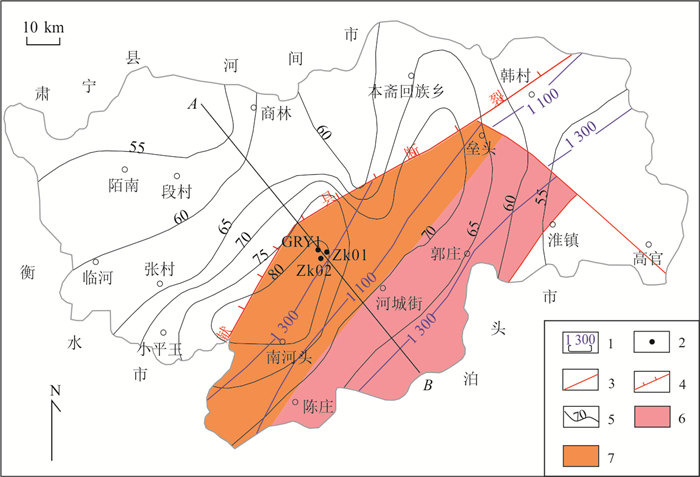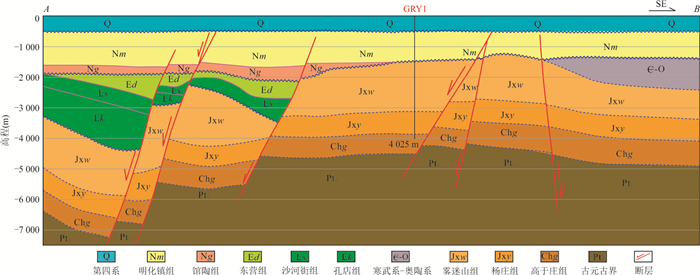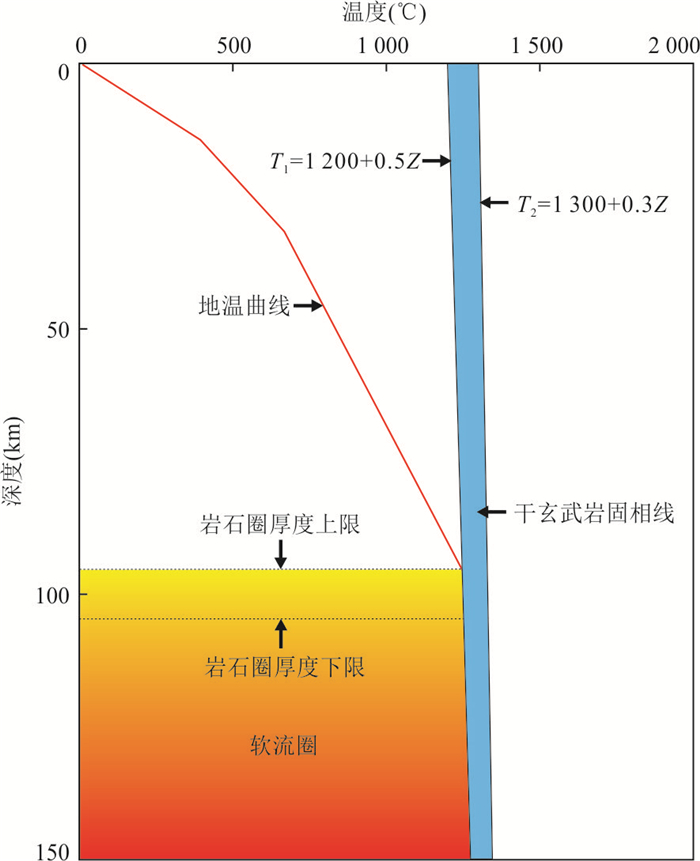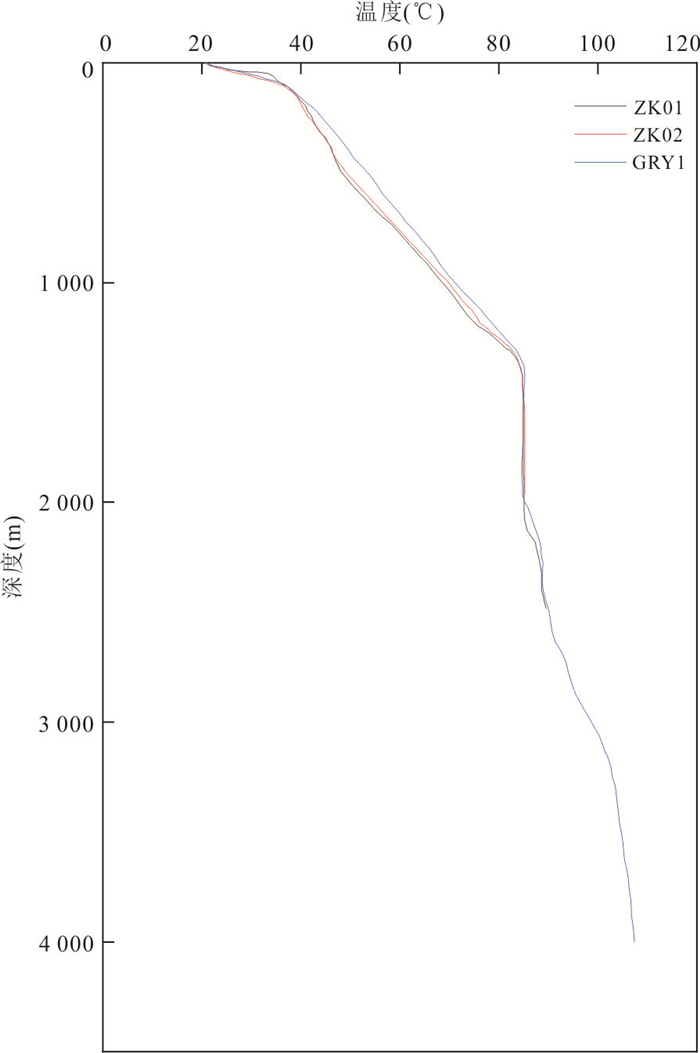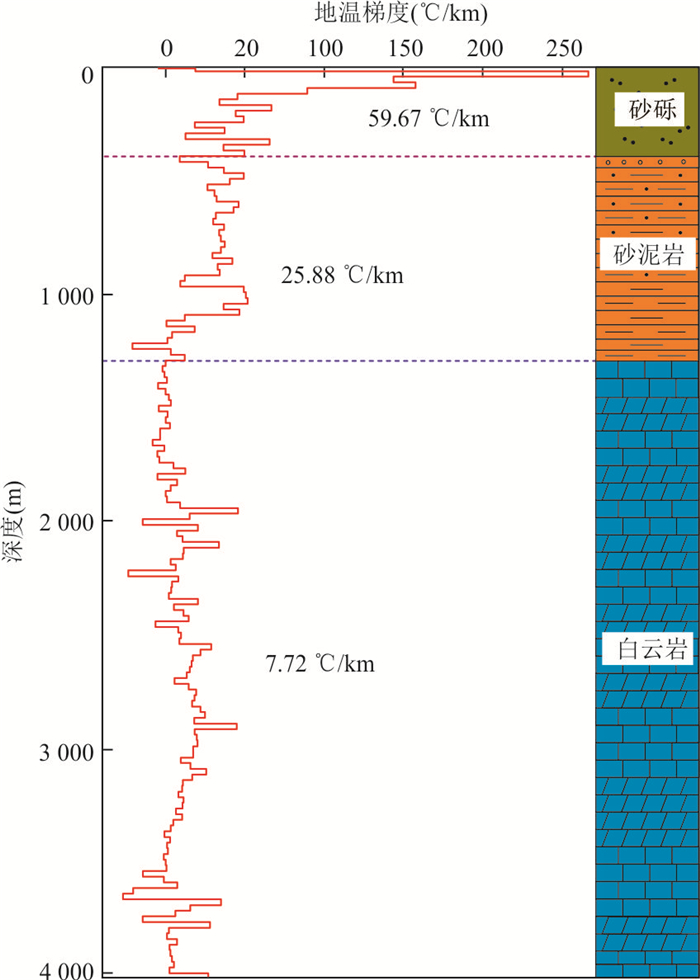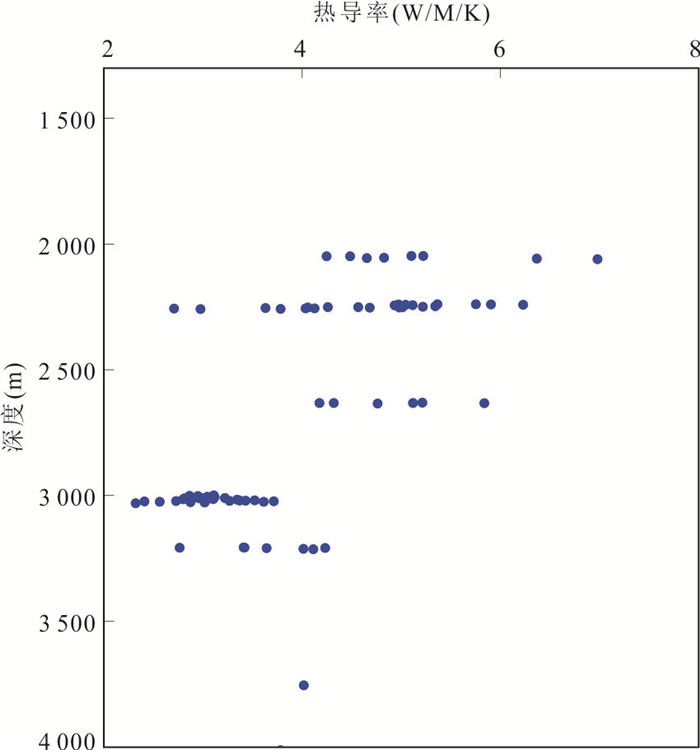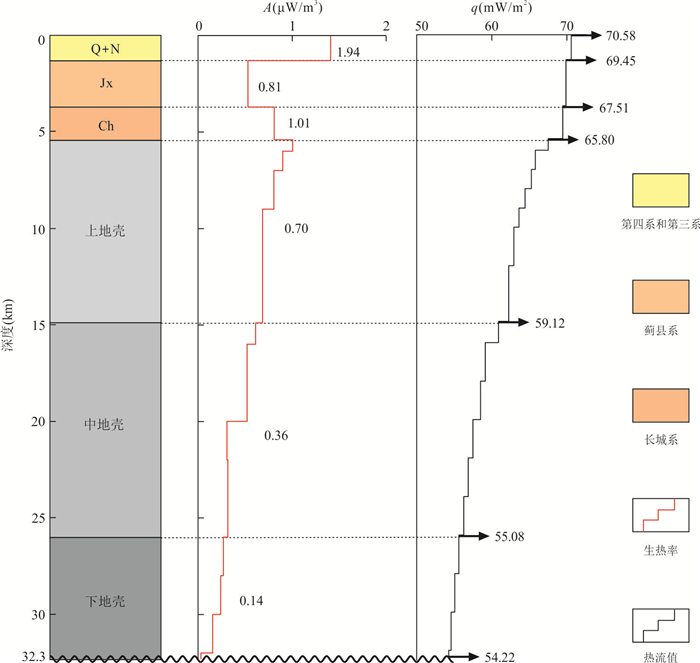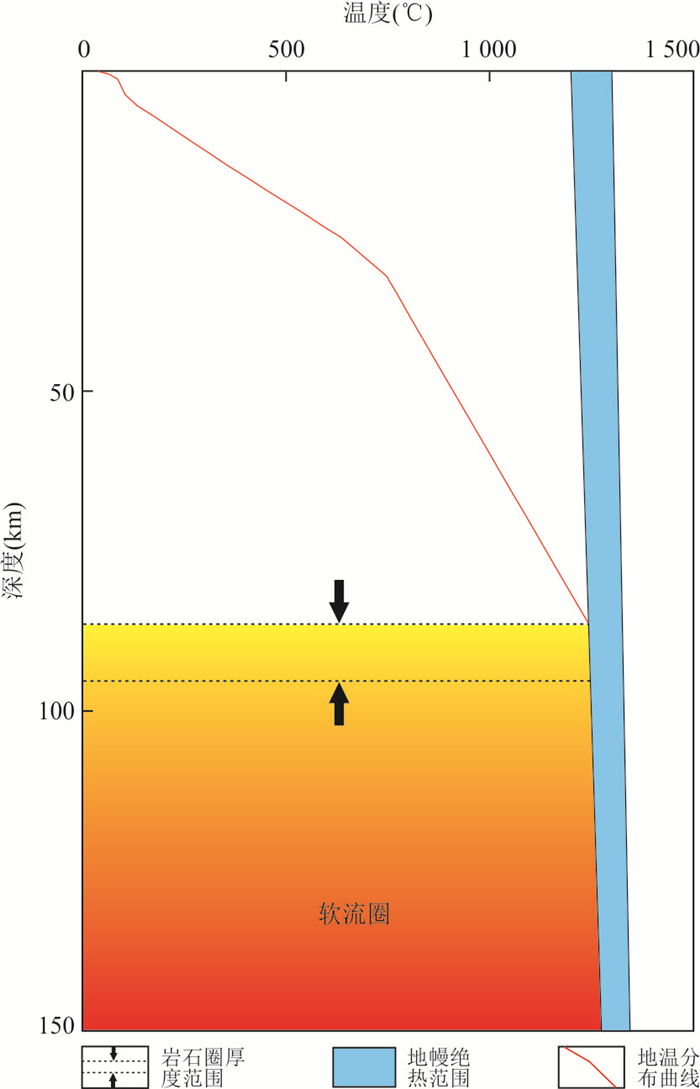Characteristics of the Terrestrial Heat Flow and Lithospheric Thermal Structure in Central Cangxian Uplift: A Case Study of Xianxian Geothermal Field
-
摘要: 岩石圈热结构是了解大陆岩石圈构造变形及演化等大陆动力学问题的重要基础,更是地热田热源机理研究的核心问题,尤其对于深部地热资源开发具有重要的科学指导意义.沧县隆起中部地热资源丰富,地热地质条件较好,但该地区岩石圈热结构尚不明确,制约着区域地热资源勘查开发.本文以沧县隆起中部献县地热田为研究区,开展了4 000 m深井测温、精细的岩土热物性测试,查明了该区大地热流特征及热结构特征,填补了大地热流测量空白区,建立了研究区岩石圈热结构概念模型,估算了其深部温度及岩石圈厚度.结果表明,献县地热田大地热流值为70.58 mW/m2,居里面埋深约为24 km,莫霍面温度约为749 ℃,热岩石圈厚度约为85~96 km.Abstract: Understanding the lithospheric thermal structure is an important basis for understanding the continental dynamics (i.e., tectonic deformation and evolution) of the continental lithosphere. It is also the core of studies on the thermal source mechanisms of geothermal fields. Most importantly, it can provide scientific guidance for the exploration and development of deep geothermal resources. The Cangxian uplift enjoys rich geothermal resources and favorable geothermal geological conditions. However, its lithospheric thermal structure is still unclear, which restricts the exploration and development of regional geothermal resources. Focusing on the Xianxian geothermal field in the middle part of the Cangxian uplift through the temperature measurement of a 4 000 m deep well and fine tests of geotechnical thermophysical properties, this study has ascertained the characteristics of the terrestrial heat flow and lithospheric thermal structure in the study area, thus filling the gap in terrestrial heat flow measurement. Moreover, this study has established a conceptual model of the lithospheric thermal structure of the study area and estimated the deep temperature and lithospheric thickness in the study area. The results show that the Xianxian geothermal field has a heat flow of 70.58 mW/m2, a burial depth of the Curie surface of about 24 km, a Moho temperature of about 749 ℃, and a lithospheric thickness of about 85-96 km.
-
表 1 GRY1孔岩心热导率及放射性生热率测试结果
Table 1. Testing results of thermal conductivity and radioactive heat production rate of cores of Borehole GRY1
深度(m) 热导率(W/m/K) U(10‒6) Th(10‒6) K2O(%) 深度(m) 热导率(W/m/K) U(10‒6) Th(10‒6) K2O(%) 1 401.60 8.573 ‒ ‒ ‒ 2 632.45 4.173 ‒ ‒ ‒ 1 401.90 7.319 ‒ ‒ ‒ 2 633.03 5.840 ‒ ‒ ‒ 1 402.18 8.431 ‒ ‒ ‒ 2 634.07 4.761 ‒ ‒ ‒ 1 402.38 7.945 ‒ ‒ ‒ 2 631.02 5.214 4.42 18.9 9.11 1 395.05 8.471 0.32 0.06 0.02 2 632.30 4.318 ‒ ‒ ‒ 1 395.65 8.324 ‒ ‒ ‒ 2 999.05 3.107 ‒ ‒ ‒ 2 048.64 4.484 ‒ ‒ ‒ 3 001.18 2.861 ‒ ‒ ‒ 2 048.76 4.247 ‒ ‒ ‒ 3 002.15 2.945 ‒ ‒ ‒ 2 054.10 4.827 ‒ ‒ ‒ 3 005.20 3.042 ‒ ‒ ‒ 2 055.53 4.652 ‒ ‒ ‒ 3 006.20 3.115 0.37 0.44 0.11 2 047.40 5.102 2.74 3.58 0.31 3 008.20 2.969 ‒ ‒ ‒ 2 047.45 5.223 ‒ ‒ ‒ 3 009.95 2.951 ‒ ‒ ‒ 2 054.51 7.459 ‒ ‒ ‒ 3 011.15 2.809 ‒ ‒ ‒ 2 058.12 6.369 ‒ ‒ ‒ 3 012.22 3.098 ‒ ‒ ‒ 2 059.10 8.122 ‒ ‒ ‒ 3 013.15 2.983 ‒ ‒ ‒ 2 059.70 6.982 ‒ ‒ ‒ 3 014.00 3.102 4.75 4.91 1.01 2 054.95 7.356 0.19 0.15 0.01 3 015.00 2.796 ‒ ‒ ‒ 2 058.55 7.271 ‒ ‒ ‒ 3 016.40 3.342 ‒ ‒ ‒ 2 239.65 5.906 ‒ ‒ ‒ 3 017.61 3.032 ‒ ‒ ‒ 2 240.20 4.972 ‒ ‒ ‒ 3 019.46 3.521 ‒ ‒ ‒ 2 241.17 5.045 ‒ ‒ ‒ 3 020.12 3.368 ‒ ‒ ‒ 2 241.32 6.231 ‒ ‒ ‒ 3 020.77 3.427 0.79 4.48 0.82 2 239.15 5.753 1.45 0.25 0.07 3 021.50 3.267 ‒ ‒ ‒ 2 239.30 5.365 ‒ ‒ ‒ 3 010.18 3.219 ‒ ‒ ‒ 2 243.07 5.116 ‒ ‒ ‒ 3 022.18 2.725 ‒ ‒ ‒ 2 243.84 4.933 ‒ ‒ ‒ 3 022.53 3.713 ‒ ‒ ‒ 2 247.45 5.343 ‒ ‒ ‒ 3 023.82 2.407 ‒ ‒ ‒ 2 249.05 5.218 ‒ ‒ ‒ 3 025.03 3.612 ‒ ‒ ‒ 2 243.27 4.981 0.74 1.45 0.72 3 024.97 2.561 ‒ ‒ ‒ 2 247.15 5.021 ‒ ‒ ‒ 3 026.73 2.871 ‒ ‒ ‒ 2 251.05 4.566 ‒ ‒ ‒ 3 028.15 3.015 0.55 2.63 0.73 2 251.85 4.055 ‒ ‒ ‒ 3 030.55 2.317 ‒ ‒ ‒ 2 252.02 4.981 ‒ ‒ ‒ 3 206.43 3.408 ‒ ‒ ‒ 2 252.76 4.681 ‒ ‒ ‒ 3 206.85 3.417 ‒ ‒ ‒ 2 250.80 4.259 1.75 4.51 0.99 3 207.51 2.762 ‒ ‒ ‒ 2 251.75 5.012 ‒ ‒ ‒ 3 208.31 4.231 ‒ ‒ ‒ 2 254.30 3.629 ‒ ‒ ‒ 3 209.01 3.641 ‒ ‒ ‒ 2 255.55 4.125 ‒ ‒ ‒ 3 212.31 4.012 1.7 8.62 4.66 2 256.18 2.706 ‒ ‒ ‒ 3 213.82 4.112 ‒ ‒ ‒ 2 257.63 3.782 ‒ ‒ ‒ 3 755.13 4.015 ‒ ‒ ‒ 2 255.70 4.034 1.19 4.46 1.45 4 013.10 3.782 ‒ ‒ ‒ 2 258.53 2.973 ‒ ‒ ‒ 4 019.57 3.401 ‒ ‒ ‒ 2 631.93 5.119 ‒ ‒ ‒ 注:“‒”表示未进行U、Th、K含量测试. 表 2 ZK01孔岩心热导率及放射性生热率测试结果
Table 2. Testing results of thermal conductivity and radioactive heat production rate of cores of Borehole ZK01
深度
(m)热导率
(W/m/K)U
(10‒6)Th
(10‒6)K2O
(%)1 340.50 4.63 0.43 0.10 0.03 1 508.00 4.12 0.55 0.15 0.05 2 017.62 2.33 1.14 0.31 0.07 表 3 沧县隆起中部岩石圈热结构计算结果
Table 3. Calculation results of lithospheric thermal structure in central Cangxian uplift
结构层 底界埋深
(km)Vp
(km/s)计算段
(km)Ai
(μW/m3)Di
(km)qi
(mW/m2)热流值(mW/m2) 上地壳 新生界 第四系 0.50 ‒ 0~0.5 1.41 0.50 0.71 70.58 第三系 1.30 ‒ 0.5~1.3 0.53 0.80 0.42 69.88 中元古界 蓟县系 3.70 ‒ 1.3~3.7 0.81 2.40 1.94 69.45 长城系 5.40 6.02 3.7~5.4 1.01 1.70 1.71 67.51 太古宇‒古元古界变质岩系结晶基底 6.00 6.06 5.4~6.0 0.90 0.60 0.54 65.80 7.00 6.10 6~7 0.81 1.00 0.81 65.26 8.00 6.10 7~8 0.81 1.00 0.81 64.45 9.00 6.16 8~9 0.68 1.00 0.68 63.64 10.00 6.16 9~10 0.68 1.00 0.68 62.96 12.00 6.16 10~12 0.68 2.00 1.37 62.27 14.90 6.20 12.0~14.9 0.61 2.90 1.78 60.90 中地壳 16.00 6.26 14.9~16.0 0.52 1.10 0.57 59.12 18.00 6.26 16~18 0.52 2.00 1.04 58.55 20.00 6.45 18~20 0.31 2.00 0.62 57.51 22.00 6.44 20~22 0.32 2.00 0.64 56.89 24.00 6.44 22~24 0.32 2.00 0.64 56.25 26.00 6.50 24~26 0.27 2.00 0.54 55.62 下地壳 28.00 6.54 26~28 0.24 2.00 0.48 55.08 30.00 6.70 28~30 0.16 2.00 0.31 54.59 32.00 7.29 30~32 0.03 2.00 0.06 54.28 32.30 7.32 32.0~32.3 0.03 0.30 0.01 54.22 表 4 沧县隆起中部地温分布计算结果
Table 4. Calculation results of temperature distribution in central Cangxian uplift
结构层 底界埋深
(km)计算段
(km)各层厚度
(km)校正后热导率
(W/m/K)平均生热率
(μW/m3)表面热流
(mW/m2)各层面底部地温
(℃)地温梯度
(℃/km)上地壳 新生界 第四系 0.50 0~0.5 0.50 ‒ 1.41 69.88 64.76 99.52 新近系 1.30 0.5~1.3 0.80 2.04 0.53 69.45 87.45 28.36 中元古界 蓟县系 3.70 1.3~3.7 2.40 3.99 0.81 67.51 105.43 7.49 长城系 5.40 3.7~5.4 1.70 3.84 1.01 65.80 134.94 17.36 太古宇‒古元古界变质岩系结晶基底 14.90 5.4~14.9 9.50 2.64 0.70 59.12 359.47 23.64 中地壳 26.00 14.9~26.0 11.10 2.30 0.36 55.08 635.15 24.84 下地壳(莫霍面) 32.20 26.0~32.2 6.20 2.97 0.14 54.22 749.15 18.39 -
Anand, J., Somerton, W. H., Gomaa, E., 1973. Predicting Thermal Conductivities of Formations from other Known Properties. Society of Petroleum Engineers Journal, 13(5): 267-273. https://doi.org/10.2118/4171⁃pa Artemieva, I. M., Mooney, W. D., 2001. Thermal Thickness and Evolution of Precambrian Lithosphere: A Global Study. Journal of Geophysical Research: Solid Earth, 106(B8): 16387-16414. https://doi.org/10.1029/2000JB900439 Cermak, V., Rybach, L., 1982. Thermal Conductivity and Specific Heat of Minerals and Rocks. In: Hellwege, K., Angenheister, G., ed., Physical Properties of Rocks. Springer, Berlin. Chi, Q. H., Yan, M. C., 1998. Radioactive Elements of Rocks in North China Platform and the Thermal Structure and Temperature Distribution of the Modern Continental Lithosphere. Chinese Journal of Geophysics, 41(1): 38-48 (in Chinese with English abstract). Clauser, C., Villinger, H., 1990. Analysis of Conductive and Convective Heat Transfer in a Sedimentary Basin, Demonstrated for the Rheingraben. Geophysical Journal International, 100(3): 393-414. https://doi.org/10.1111/j.1365⁃246X.1990.tb00693.x Cui, Y., Zhu, C. Q., Qiu, N. S., et al., 2020. Geothermal Lithospheric Thickness in the Central Jizhong Depression and Its Geothermal Significance. Acta Geologica Sinica, 94(7): 1960-1969 (in Chinese with English abstract). doi: 10.3969/j.issn.0001-5717.2020.07.005 Ding, Z. Y., Wang, L. S., Hu, W. X., et al., 2008. Reconstruction of Cenozoic Thermal History of Bohai Bay Basin with a Transient Heat Flow Model. Acta Petrolei Sinica, 29(5): 650-656 (in Chinese with English abstract). doi: 10.3321/j.issn:0253-2697.2008.05.004 Duan, Y. H., Liu, B. J., Zhao, J. R., et al., 2015. 2⁃D P⁃Wave Velocity Structure of Lithosphere in the North China Tectonic Zone: Constraints from the Yancheng⁃Baotou Deep Seismic Profile. Science in China (Series D), 45(8): 1183-1197 (in Chinese). Feng, C. G., Liu, S. W., Wang, L. S., et al., 2009. Present⁃Day Geothermal Regime in Tarim Basin, Northwest China. Chinese Journal of Geophysics, 52(11): 2752-2762 (in Chinese with English abstract). Furlong, K. P., Chapman, D. S., 2013. Heat Flow, Heat Generation, and the Thermal State of the Lithosphere. Annual Review of Earth and Planetary Sciences, 41(1): 385-410. https://doi.org/10.1146/annurev.earth.031208.100051 Gong, Y. L., Wang, L. S., Liu, S. W., 2011. The Thermal Structure and Thermal Evolution of Bohai Bay Basin in East China. Atomic Energy Press, Beijing (in Chinese). He, L. J., Hu, S. B., Huang, S. P., et al., 2008. Heat Flow Study at the Chinese Continental Scientific Drilling Site: Borehole Temperature, Thermal Conductivity, and Radiogenic Heat Production. Journal of Geophysical Research Atmospheres, 113(B2): B02404. https://doi.org/10.1029/2007jb004958 Hou, G. T., Qian, X. L., Cai, D. S., 2001. The Tectonic Evolution of Bohai Basin in Mesozoic and Cenozoic Time. Acta Scicentiarum Naturalum Universitis Pekinesis, 37(6): 845-851 (in Chinese with English abstract). Huang, F., He, L. J., Wu, Q. J., 2015. Lithospheric Thermal Structure of the Ordos Basin and Its Implications to Destruction of the North China Craton. Chinese Journal of Geophysics, 58(10): 3671-3686 (in Chinese with English abstract). Hyndman, R. D., Lambert, I. B., Heier, K. S., et al., 1968. Heat Flow and Surface Radioactivity Measurements in the Precambrian Shield of Western Australia. Physics of the Earth and Planetary Interiors, 1(2): 129-135. https://doi.org/10.1016/0031⁃9201(68)90057⁃5 Jia, S. X., Zhang, X. K., 2005. Crustal Structure and Comparison of Different Tectonic Blocks in North China. Chinese Journal of Geophysics, 48(3): 611-620 (in Chinese with English abstract). doi: 10.1002/cjg2.694 Lachenbruch, A. H., 1970. Crustal Temperature and Heat Production: Implications of the Linear Heat⁃Flow Relation. Journal of Geophysical Research Atmospheres, 75(17): 3291-3300. https://doi.org/10.1029/jb075i017p03291 Lachenbruch, A. H., Sass, J. H., 1977. Heat Flow in the United States and the Thermal Regime of the Crust. In: Spilhaus, A. F., Managing, J., eds., The Earth's Crust, Its Nature and Physical Properties. Geophysical Monograph, 20: 332-359. https://doi.org/10.1029/GM020p0626 Li, C., Chen, S. Y., Lou, D., et al., 2021. Geochemical Characteristics and Signatures of Mesozoic Sandstones from Huanghua Depression. Earth Science, 46(8): 2903-2918 (in Chinese with English abstract). Liu, F., Wang, G. L., Zhang, W., et al., 2020. Terrestrial Heat Flow and Lithospheric Thermal Structure in the Middle Yanshan Region: A Case Study from the Qijia⁃Maojingba Geothermal Field in Chengde. Acta Geologica Sinica, 94(7): 1950-1959 (in Chinese with English abstract). doi: 10.3969/j.issn.0001-5717.2020.07.004 Morgan, P., 1984. The Thermal Structure and Thermal Evolution of the Continental Lithosphere. Physics and Chemistry of the Earth, 15: 107-193. https://doi.org/10.1016/0079⁃1946(84)90006⁃5 Njiteu Tchoukeu, C. D., Basseka, C. A., Djomani, Y. P., et al., 2021. Crustal Thickness, Depth to the Bottom of Magnetic Sources and Thermal Structure of the Crust from Cameroon to Central African Republic: Preliminary Results for a Better Understanding of the Origin of the Bangui Magnetic Anomaly. Journal of African Earth Sciences, 179: https://doi.org/10.1016/j.jafrearsci.2021.104206 Pribnow, D., Williams, C. F., Sass, J. H., et al., 2013. Thermal Conductivity of Water⁃Saturated Rocks from the KTB Pilot Hole at Temperatures of 25 to 300 ℃. Geophysical Research Letters, 23(4): 391-394. https://doi.org/10.1029/95GL00253 Qiu, N. S., Wei, G., Li, C. C., et al., 2009. Distribution Features of Current Geothermal Field in the Bohai Sea Waters. Oil & Gas Geology, 30(4): 412-419 (in Chinese with English abstract). Qiu, N. S., Zuo, Y. H., Chang, J., et al., 2014. Geothermal Evidence of Meso⁃Cenozoic Lithosphere Thinning in the Jiyang Sub⁃Basin, Bohai Bay Basin, Eastern North China Craton. Gondwana Research, 26(3-4): 1079-1092. https://doi.org/10.1016/j.gr.2013.08.011 Qiu, N. S., Zuo, Y. H., Chang, J., et al., 2015. Characteristics of Meso⁃Cenozoic Thermal Regimes in Typical Eastern and Western Sedimentary Basins of China. Earth Science Frontiers, 22(1): 157-168 (in Chinese with English abstract). Rao, S., Hu, S. B., Zhu, C. Q., et al., 2013. The Characteristics of Heat Flow and Lithospheric Thermal Structure in Junggar Basin, Northwest China. Chinese Journal of Geophysics, 56(8): 2760-2770 (in Chinese with English abstract). Rao, S., Jiang, G. Z., Gao, Y. J., et al., 2016. The Thermal Structure of the Lithosphere and Heat Source Mechanism of Geothermal Field in Weihe Basin. Chinese Journal of Geophysics, 59(6): 2176-2190 (in Chinese with English abstract). Rudnick, R. L., McDonough, W. F., O'Connell, R. J., 1998. Thermal Structure, Thickness and Composition of Continental Lithosphere. Chemical Geology, 145(3-4): 395-411. https://doi.org/10.1016/S0009⁃2541(97)00151⁃4 Rybach, L., 1976. Radioactive Heat Production in Rocks and Its Relation to other Petrophysical Parameters. Pure and Applied Geophysics, 114(2): 309-317. https://doi.org/10.1007/BF00878955 Rybach, L., Buntebarth, G., 1984. The Variation of Heat Generation, Density and Seismic Velocity with Rock Type in the Continental Lithosphere. Tectonophysics, 103(1-4): 335-344. doi: 10.1016/0040-1951(84)90095-7 Sass, J. H., Lachenbruch, A. H., Moses, T. H. Jr, et al., 1992. Heat Flow from a Scientific Research Well at Cajon Pass, California. Journal of Geophysical Research Atmospheres, 97(B4): 5017. https://doi.org/10.1029/91jb01504 Schintgen, T., Förster, A., Förster, H. J., et al., 2015. Surface Heat Flow and Lithosphere Thermal Structure of the Rhenohercynian Zone in the Greater Luxembourg Region. Geothermics, 56: 93-109. https://doi.org/10.1016/j.geothermics.2015.03.007 Shi, Y. Z., Rop, E., Wang, Z. C., et al., 2021. Characteristics and Formation Mechanism of the Olkaria Geothermal System, Kenya Revealed by Well Temperature Data. Geothermics, 97: 102243. https://doi.org/10.1016/j.geothermics.2021.102243 Wang, D. Y., Luo, Z. J., Liu, C. Y., 1997. Palaeozoic Hydrocaron Potential Evaluation for Cangxian Uplift. Petroleum Exploration and Development, 24(4): 8-11 (in Chinese with English abstract). Wang, L. S., Liu, S. W., Xiao, W. Y., et al., 2002. Distribution Feature of Terrestrial Heat Flow Densities in the Bohai Basin, East China. Chinese Science Bulletin, 47(2): 151-155 (in Chinese). doi: 10.1360/csb2002-47-2-151 Wang, Z. T., Zhang, C., Jiang, G. Z., et al., 2019. Present⁃Day Geothermal Field of Xiongan New Area and Its Heat Source Mechanism. Chinese Journal of Geophysics, 62(11): 4313-4322 (in Chinese with English abstract). Xue, Y. A., Zhao, M., Liu, X. J., 2021. Reservoir Characteristics and Controlling Factors of the Metamorphic Buried Hill of Bozhong Sag, Bohai Bay Basin. Journal of Earth Science, 32(4): 919-926. https://doi.org/10.1007/s12583⁃021⁃1415⁃1 Zhang, B. H., Zhang, J., Qu, J. F., et al., 2021. Lüliangshan: A Mesozoic Basement Involved Fold System in the Central North China Craton. Earth Science, 46(7): 2423-2448 (in Chinese with English abstract). Zhang, C., Jiang, G. Z., Shi, Y. Z., et al., 2018. Terrestrial Heat Flow and Crustal Thermal Structure of the Gonghe⁃Guide Area, Northeastern Qinghai⁃Tibetan Plateau. Geothermics, 72: 182-192. https://doi.org/10.1016/j.geothermics.2017.11.011 迟清华, 鄢明才, 1998. 华北地台岩石放射性元素与现代大陆岩石圈热结构和温度分布. 地球物理学报, 41(1): 38-48. https://www.cnki.com.cn/Article/CJFDTOTAL-DQWX199801004.htm 崔悦, 朱传庆, 邱楠生, 等, 2020. 冀中坳陷中部现今岩石圈厚度及地热学意义探讨. 地质学报, 94(7): 1960-1969. doi: 10.3969/j.issn.0001-5717.2020.07.005 丁增勇, 王良书, 胡文瑄, 等, 2008. 利用岩石圈瞬态热流模型重建渤海湾盆地新生代热历史. 石油学报, 29(5): 650-656. doi: 10.3321/j.issn:0253-2697.2008.05.004 段永红, 刘保金, 赵金仁, 等, 2015. 华北构造区岩石圈二维P波速度结构特征: 来自盐城‒包头深地震测深剖面的约束. 中国科学(D辑), 45(8): 1183-1197. https://www.cnki.com.cn/Article/CJFDTOTAL-JDXK201508008.htm 冯昌格, 刘绍文, 王良书, 等, 2009. 塔里木盆地现今地热特征. 地球物理学报, 52(11): 2752-2762. https://www.cnki.com.cn/Article/CJFDTOTAL-DQWX200911011.htm 龚育龄, 王良书, 刘绍文, 2011. 中国东部渤海湾盆地热结构和热演化. 北京: 原子能出版社. 侯贵廷, 钱祥麟, 蔡东升, 2001. 渤海湾盆地中、新生代构造演化研究. 北京大学学报(自然科学版), 37(6): 845-851. https://www.cnki.com.cn/Article/CJFDTOTAL-BJDZ200106016.htm 黄方, 何丽娟, 吴庆举, 2015. 鄂尔多斯盆地深部热结构特征及其对华北克拉通破坏的启示. 地球物理学报, 58(10): 3671-3686. https://www.cnki.com.cn/Article/CJFDTOTAL-DQWX201510020.htm 嘉世旭, 张先康, 2005. 华北不同构造块体地壳结构及其对比研究. 地球物理学报, 48(3): 611-620. https://www.cnki.com.cn/Article/CJFDTOTAL-DQWX200503018.htm 李晨, 陈世悦, 楼达, 等, 2021. 黄骅坳陷中生界砂岩地球化学特征及意义. 地球科学, 46(8): 2903-2918. doi: 10.3799/dqkx.2020.325 刘峰, 王贵玲, 张薇, 等, 2020. 燕山中部大地热流及岩石圈热结构特征: 以承德市七家‒茅荆坝地热田为例. 地质学报, 94(7): 1950-1959. https://www.cnki.com.cn/Article/CJFDTOTAL-DZXE202007004.htm 邱楠生, 魏刚, 李翠翠, 等, 2009. 渤海海域现今地温场分布特征. 石油与天然气地质, 30(4): 412-419. https://www.cnki.com.cn/Article/CJFDTOTAL-SYYT200904008.htm 邱楠生, 左银辉, 常健, 等, 2015. 中国东西部典型盆地中‒新生代热体制对比. 地学前缘, 22(1): 157-168. https://www.cnki.com.cn/Article/CJFDTOTAL-DXQY201501015.htm 饶松, 胡圣标, 朱传庆, 等, 2013. 准噶尔盆地大地热流特征与岩石圈热结构. 地球物理学报, 56(8): 2760-2770. https://www.cnki.com.cn/Article/CJFDTOTAL-DQWX201308025.htm 饶松, 姜光政, 高雅洁, 等, 2016. 渭河盆地岩石圈热结构与地热田热源机理. 地球物理学报, 59(6): 2176-2190. https://www.cnki.com.cn/Article/CJFDTOTAL-DQWX201606022.htm 王定一, 罗铸金, 刘池阳, 1997. 沧县隆起地区古生界油气远景评价. 石油勘探与开发, 24(4): 8-11. https://www.cnki.com.cn/Article/CJFDTOTAL-SKYK199704003.htm 王良书, 刘绍文, 肖卫勇, 等, 2002. 渤海盆地大地热流分布特征. 科学通报, 47(2): 151-155. https://www.cnki.com.cn/Article/CJFDTOTAL-KXTB200202018.htm 王朱亭, 张超, 姜光政, 等, 2019. 雄安新区现今地温场特征及成因机制. 地球物理学报, 62(11): 4313-4322. https://www.cnki.com.cn/Article/CJFDTOTAL-DQWX201911026.htm 张北航, 张进, 曲军峰, 等, 2021. 吕梁山——华北克拉通中部中生代基底卷入褶皱系统. 地球科学, 46(7) : 2423-2448. doi: 10.3799/dqkx.2020.235 -









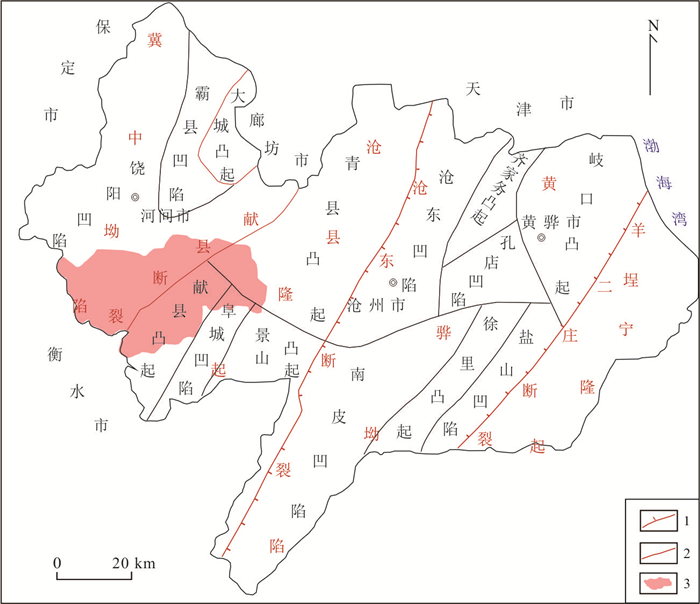
 下载:
下载:
